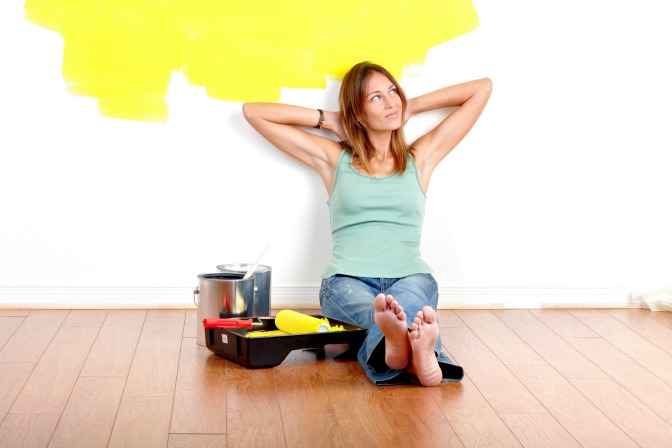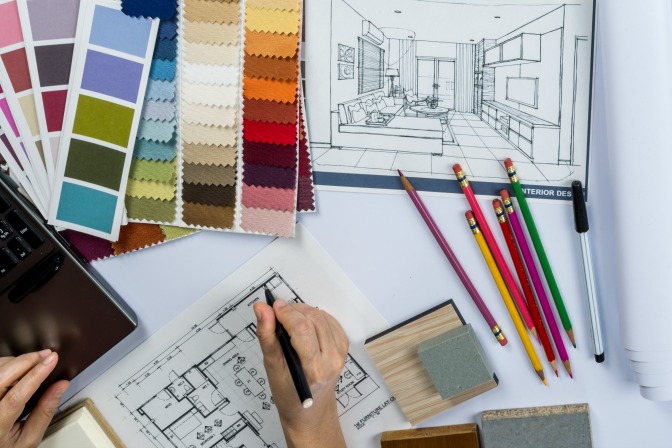Interior decorating is a global multi-billion dollar industry. And with certification, there are plenty of opportunities for interior decorators to grow: corporate clients, home design, and booming sustainable design movements are just some of the many areas that interior decorators are in demand.
Some clients dream of a space that reflects their true style, but they just don’t know how to make it happen. That’s where you come in. Clients may come at you with pages from every décor magazine they can find. Other times a client won’t have a clue of what kind of aesthetic they want. A professional interior decorator will be able to transform a lackluster room into a stylish and functional design—no matter the space or budget.
Are you wondering what comes next now that you’ve decided to get your interior decorating certification? Take a look at some things you can expect on the road to getting certified. If you put in the hard work, creativity, and commitment, you can turn your passion for interior decorating from a hobby into a successful career!
 The interior decorating certification process is straightforward. You’ll learn design theory, complete assignments, and apply everything you’ve learned through practice.
Program length will differ depending on the institution or if you choose a fast-tracking stream. You may find shorter programs more beneficial if want to enter the industry as quickly as you can. Since certificate programs are pretty flexible, you’ll be out in the real world doing what you love in no time!
The interior decorating certification process is straightforward. You’ll learn design theory, complete assignments, and apply everything you’ve learned through practice.
Program length will differ depending on the institution or if you choose a fast-tracking stream. You may find shorter programs more beneficial if want to enter the industry as quickly as you can. Since certificate programs are pretty flexible, you’ll be out in the real world doing what you love in no time!
 Communication is a huge part of interior decorating. You’ll need to be able to build trusting relationships with your clients. In order to come up with a suitable decorating scheme, you need to know what kind of questions to ask. Function, lifestyle, and budget are just a few factors you’ll need to keep in mind during a first consultation.
And then comes the pitch. You’ll have to be able to present your ideas. A captivating design won’t interest any potential clients if you can’t properly articulate your concept. While you’ll learn how to draw your design, you’ll also learn the relevant industry terminology to use.
Creating a design scheme that goes above and beyond the expectations of your client also depends on your ability to engage with your client during meetings. On top of the design skills you’ll develop, you’ll learn how to effectively communicate with clients—meaning your decorating scheme will reflect exactly what your client wants.
Communication is a huge part of interior decorating. You’ll need to be able to build trusting relationships with your clients. In order to come up with a suitable decorating scheme, you need to know what kind of questions to ask. Function, lifestyle, and budget are just a few factors you’ll need to keep in mind during a first consultation.
And then comes the pitch. You’ll have to be able to present your ideas. A captivating design won’t interest any potential clients if you can’t properly articulate your concept. While you’ll learn how to draw your design, you’ll also learn the relevant industry terminology to use.
Creating a design scheme that goes above and beyond the expectations of your client also depends on your ability to engage with your client during meetings. On top of the design skills you’ll develop, you’ll learn how to effectively communicate with clients—meaning your decorating scheme will reflect exactly what your client wants.
 No two designs are ever the same. Your job will be to see the potential in whatever space you are working with. Sometimes what a client wants is in conflict with the limitations of a room; however, you’ll be able to evaluate a site and come up with a suitable decorating scheme that also keeps your client happy.
When a client approaches you, you’ll need to be able to show them that you can provide the interior decorating services they need. This means you will be thinking quickly on your feet in terms of style, design, and execution. Clients place an immense amount of trust in interior decorators. Every step from your initial sketch to the finished look will depend on your design flexibility.
This is where you showcase your flair for style! Clients, budgets, and rooms are all different! As an interior decorator, you will become well-versed in classic design and trained to adapt different styles to a specific space. No matter what resources you are working with, you’ll be able to approach any room and determine exactly what it needs: eye-catching décor, window-treatments, floor layout, and the perfect color schemes.
No two designs are ever the same. Your job will be to see the potential in whatever space you are working with. Sometimes what a client wants is in conflict with the limitations of a room; however, you’ll be able to evaluate a site and come up with a suitable decorating scheme that also keeps your client happy.
When a client approaches you, you’ll need to be able to show them that you can provide the interior decorating services they need. This means you will be thinking quickly on your feet in terms of style, design, and execution. Clients place an immense amount of trust in interior decorators. Every step from your initial sketch to the finished look will depend on your design flexibility.
This is where you showcase your flair for style! Clients, budgets, and rooms are all different! As an interior decorator, you will become well-versed in classic design and trained to adapt different styles to a specific space. No matter what resources you are working with, you’ll be able to approach any room and determine exactly what it needs: eye-catching décor, window-treatments, floor layout, and the perfect color schemes.
 Interior decorating and organization go hand in hand. You may have a natural eye for decorating, but in order to bring your design to life, you also need to have a firm grasp on the logistics of your project. Successful interior decorators plan and budget way before a single piece of furniture is moved. That means learning how to design a floorplan, sketch a layout, and successfully pitch your design concept to a potential client.
Once you do begin interior decorating, you will have to manage your timeline from beginning to end. For projects that involve larger home renovations, you’ll be coordinating multiple projects while ensuring clients are satisfied with your work. Keeping on time and on budget is challenge. Deadlines may shift and different issues can always crop up. However, learning appropriate time management is an important part of the certification process. By the time you finish your program, you’ll not only be confident in your decorating skills, you’ll also be able to carry out a beautiful design within a tight timeframe.
Interior decorating and organization go hand in hand. You may have a natural eye for decorating, but in order to bring your design to life, you also need to have a firm grasp on the logistics of your project. Successful interior decorators plan and budget way before a single piece of furniture is moved. That means learning how to design a floorplan, sketch a layout, and successfully pitch your design concept to a potential client.
Once you do begin interior decorating, you will have to manage your timeline from beginning to end. For projects that involve larger home renovations, you’ll be coordinating multiple projects while ensuring clients are satisfied with your work. Keeping on time and on budget is challenge. Deadlines may shift and different issues can always crop up. However, learning appropriate time management is an important part of the certification process. By the time you finish your program, you’ll not only be confident in your decorating skills, you’ll also be able to carry out a beautiful design within a tight timeframe.
The process
 The interior decorating certification process is straightforward. You’ll learn design theory, complete assignments, and apply everything you’ve learned through practice.
Program length will differ depending on the institution or if you choose a fast-tracking stream. You may find shorter programs more beneficial if want to enter the industry as quickly as you can. Since certificate programs are pretty flexible, you’ll be out in the real world doing what you love in no time!
The interior decorating certification process is straightforward. You’ll learn design theory, complete assignments, and apply everything you’ve learned through practice.
Program length will differ depending on the institution or if you choose a fast-tracking stream. You may find shorter programs more beneficial if want to enter the industry as quickly as you can. Since certificate programs are pretty flexible, you’ll be out in the real world doing what you love in no time!
What can you expect to learn?
While many certification programs will differ in course content, you can likely expect to learn these key concepts:- Planning timelines and budgets
- Creating a client profile
- Presenting your design to potential clients
- Working with vendors and other industry professionals
- Performing a site evaluation
- Preparing a floorplan and initial design sketch
- Drawing professional floorplans
- Identifying classic design elements
- Working with color, textiles, and patterns
- Building a style and choosing appropriate materials for your clients’ needs
- Building a strong portfolio
- Marketing and promotion of your interior decorating services
Skills you’ll develop
In addition to extensive design knowledge, you’ll pick up (or strengthen) numerous other invaluable skills that will enable you to go above and beyond the expectation of your client. Not only will you learn the fundamental basics of interior decorating, you’ll know how to tailor your services and develop client relationships.Interpersonal communication
 Communication is a huge part of interior decorating. You’ll need to be able to build trusting relationships with your clients. In order to come up with a suitable decorating scheme, you need to know what kind of questions to ask. Function, lifestyle, and budget are just a few factors you’ll need to keep in mind during a first consultation.
And then comes the pitch. You’ll have to be able to present your ideas. A captivating design won’t interest any potential clients if you can’t properly articulate your concept. While you’ll learn how to draw your design, you’ll also learn the relevant industry terminology to use.
Creating a design scheme that goes above and beyond the expectations of your client also depends on your ability to engage with your client during meetings. On top of the design skills you’ll develop, you’ll learn how to effectively communicate with clients—meaning your decorating scheme will reflect exactly what your client wants.
Communication is a huge part of interior decorating. You’ll need to be able to build trusting relationships with your clients. In order to come up with a suitable decorating scheme, you need to know what kind of questions to ask. Function, lifestyle, and budget are just a few factors you’ll need to keep in mind during a first consultation.
And then comes the pitch. You’ll have to be able to present your ideas. A captivating design won’t interest any potential clients if you can’t properly articulate your concept. While you’ll learn how to draw your design, you’ll also learn the relevant industry terminology to use.
Creating a design scheme that goes above and beyond the expectations of your client also depends on your ability to engage with your client during meetings. On top of the design skills you’ll develop, you’ll learn how to effectively communicate with clients—meaning your decorating scheme will reflect exactly what your client wants.
Creativity and problem solving
 No two designs are ever the same. Your job will be to see the potential in whatever space you are working with. Sometimes what a client wants is in conflict with the limitations of a room; however, you’ll be able to evaluate a site and come up with a suitable decorating scheme that also keeps your client happy.
When a client approaches you, you’ll need to be able to show them that you can provide the interior decorating services they need. This means you will be thinking quickly on your feet in terms of style, design, and execution. Clients place an immense amount of trust in interior decorators. Every step from your initial sketch to the finished look will depend on your design flexibility.
This is where you showcase your flair for style! Clients, budgets, and rooms are all different! As an interior decorator, you will become well-versed in classic design and trained to adapt different styles to a specific space. No matter what resources you are working with, you’ll be able to approach any room and determine exactly what it needs: eye-catching décor, window-treatments, floor layout, and the perfect color schemes.
No two designs are ever the same. Your job will be to see the potential in whatever space you are working with. Sometimes what a client wants is in conflict with the limitations of a room; however, you’ll be able to evaluate a site and come up with a suitable decorating scheme that also keeps your client happy.
When a client approaches you, you’ll need to be able to show them that you can provide the interior decorating services they need. This means you will be thinking quickly on your feet in terms of style, design, and execution. Clients place an immense amount of trust in interior decorators. Every step from your initial sketch to the finished look will depend on your design flexibility.
This is where you showcase your flair for style! Clients, budgets, and rooms are all different! As an interior decorator, you will become well-versed in classic design and trained to adapt different styles to a specific space. No matter what resources you are working with, you’ll be able to approach any room and determine exactly what it needs: eye-catching décor, window-treatments, floor layout, and the perfect color schemes.
Organization and time management
 Interior decorating and organization go hand in hand. You may have a natural eye for decorating, but in order to bring your design to life, you also need to have a firm grasp on the logistics of your project. Successful interior decorators plan and budget way before a single piece of furniture is moved. That means learning how to design a floorplan, sketch a layout, and successfully pitch your design concept to a potential client.
Once you do begin interior decorating, you will have to manage your timeline from beginning to end. For projects that involve larger home renovations, you’ll be coordinating multiple projects while ensuring clients are satisfied with your work. Keeping on time and on budget is challenge. Deadlines may shift and different issues can always crop up. However, learning appropriate time management is an important part of the certification process. By the time you finish your program, you’ll not only be confident in your decorating skills, you’ll also be able to carry out a beautiful design within a tight timeframe.
Interior decorating and organization go hand in hand. You may have a natural eye for decorating, but in order to bring your design to life, you also need to have a firm grasp on the logistics of your project. Successful interior decorators plan and budget way before a single piece of furniture is moved. That means learning how to design a floorplan, sketch a layout, and successfully pitch your design concept to a potential client.
Once you do begin interior decorating, you will have to manage your timeline from beginning to end. For projects that involve larger home renovations, you’ll be coordinating multiple projects while ensuring clients are satisfied with your work. Keeping on time and on budget is challenge. Deadlines may shift and different issues can always crop up. However, learning appropriate time management is an important part of the certification process. By the time you finish your program, you’ll not only be confident in your decorating skills, you’ll also be able to carry out a beautiful design within a tight timeframe.
